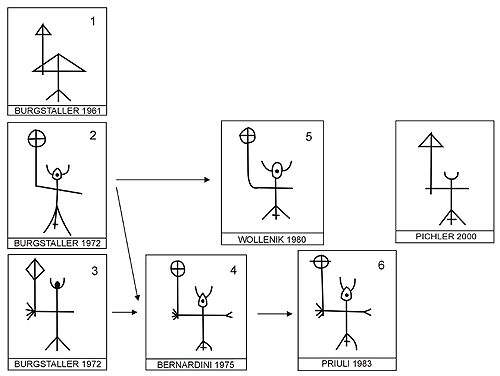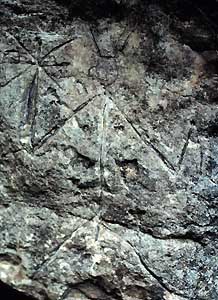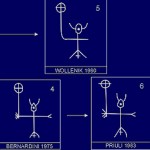The rock art site “Höll” in Upper Austria was documented in the fifties. In the international literature it is the best known place in Austria…
by Werner PICHLER
 |
A diabolical metamorphosis
the consequences of a wrong documentation
and a chain of quotations
The rock art site “Höll” in the Warschenck mountains near Spital/P. in Upper Austria was documented in the fifties by Burgstaller and Lauth, a comprehensive description was published in 1961. In the international literature it is the best known place in Austria: cited in several books, represented with photos and drawings in several museums.
On the occasion of a new conception of the “Austrian Rock Art Museum” in Spital/P. in 1999 it became clearer and clearer that some of the central aspects of Burgstallers documentation and interpretation cannot be maintained anymore. Thus a very clear refutation of Burgstallers thesis of palaeolithic engravings took place (Pichler 2000). In addition a re-examination of the published drawings of rock art panels from the site “Höll” brought to light that a lot of them do not correspond with reality. Though Burgstaller explained that Lauth made the drawings on the basis of exact photos, we nowadays must state their incorrectness and gross contradictions. So it will be necessary to start a new documentation of “Höll”.
The possible consequences of a wrong documentation will be demonstrated by one motif: a supposed human figure from rock 2.
The first description of the figure – based on drawing 1 – sounds as follows (1961:65):
“ein geschäftetes Dreieck mit Basis von 13 cm, dessen Schaft wurzelartig in einem Dreisproß endet (…) links oberhalb ein zweites, kleines gleichseitiges Dreieck (4 cm), das auf einem gleichzeitig seine Höhenlinie bildenden 14 cm hohen Schaft ruht”.
In Burgstallers standard book “Felsbilder in Österreich” (1972) we find two totally different drawings. In the course of the interpretation Burgstaller himself states that this new view differs from the first “a little bit” because of better methods of documentation. It is no surprise that the verbal description sounds very different too (1972:17):
“die 22 cm große Figur eines in statuarischer Haltung wiedergegebenen Mannes – seine Geschlechtszugehörigkeit ist ausdrücklich hervorgehoben (…). Die in strenger linearer Stilisierung wiedergegebene Gestalt hält die Arme kreuzartig waagrecht ausgestreckt, die linke Hand hält an einem senkrechten Stab ein vierspeichiges Rad hoch. Das winzige Haupt des Radträgers besteht nur aus einem kleinen Kreis mit einem Punkt als Auge. Von der Stirnpartie geht beidseitig je ein kurzer Schrägstrich aus, die das Haupt gehörnt erscheinen lassen.”
The term “a little bit” sounds minimising for the differences in picture and text: both triangles have disappeared, being replaced by a circle with cross and a head with horns and one eye. To our great surprise we find a second drawing of the same figure in the same book: now the circle is replaced by a rhomb, the head contracted to a dot and the hand got three fingers.
On the basis of this new point of view Burgstaller felt encouraged to a risky interpretation of the motif as a “sacral figure” of a “Radträger” – thus comparable with a motif from Kienbachklamm. He states connections to the celtic mythology and to the Roman “Jupiter Maximus”. By these means two little triangles transformed to a god carrying a ritual wheel in his hand.

Fig. 1
Studying the original documentation records (Archives of Österr. Felsbildermuseum, Spital/P.) the central problem at that timecan soon be recognised: Burgstaller and his assistant Lauth didn’t use photos but freehand drawings for their publications. Thus it is no surprise that each visit at “Höll” (under different circumstances of light and humidity) resulted in very divergent drawings. Fig. 1 shows the results of the first inspections in 1958 – 1960.

Fig. 2
Now let’s follow the chain of tradition (Fig. 2):
- Bernardini (1975: fig. 79/5) takes version 2, but supplemented by four fingers on the right and two on the left hand, the circle is interpreted as a solar symbol.
- Wollenik (1980:90/Tafel 3) strictly follows version 2 and describes a “Radkreuzträger”.
- Priuli (1983:31/fig.42) takes Bernardinis version with two and four fingers and agrees with the interpretation as a solar symbol. But he refers to the horns and compares the figure with the famous “diabolo” from Tunkelbald/Val d’Assa.

Tunkelwald, Val d’Assa
Why did practically all the followers prefer version 2? The answer is simple: Version 1 was published in a periodical with very local distribution (Oberösterreichische Heimatblätter), version 3 is a very tiny figure in the appendix of a book. So it is no surprise that version 2 printed in a well-sold book had the greatest distribution.
And what are the results of a careful re-examination of rock “Höll 2” in 2000:
- Firstly: there is absolutely no “Radkreuz” and no rhomb but a simple triangle.
- Secondly: There are no fingers.
- Thirdly: There is a short line forming a little cross at the place of the “penis”.
- Fourthly: There is only a little indication of a head, surely no horns. And the little dot is – with great probability – a natural hollow in the rock surface as many other around the figure.
What are the conclusions to be drawn from this “diabolical metamorphosis”? It is by no means intended to turn to ridicule the work of rock art pioneers like Burgstaller.
But: It is very dangerous to take those documentations as sacrosanct, to cite them forever without any re-examination.
And: this should not only be a lesson concerning “patriarchal” rock art research but also for actual work – no documentation is perfect, only a continuous process of re-examinations will provide approximation to “reality”.
Werner Pichler
INSTITUTUM CANARIUM
Wagrainerstr. 9
A-4840 Vöcklabruck
References
- Bernardini E. 1975. Arte millenaria sulle rocce alpine. Milano.
- Burgstaller E. 1972. Felsbilder in Österreich. Linz.
- Ebers E., Wollenik F. 1980. Felsbilder der Alpen. Hallein.
- Pichler W. 2000. Palaeolithic Rock Art in the Austrian Alps?















Leave a Reply